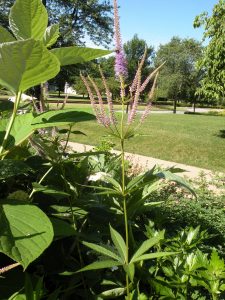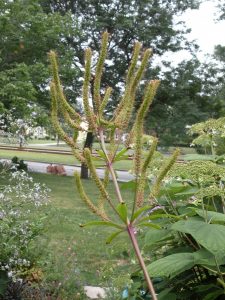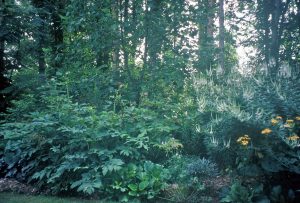
Veronicastrum (the white spires in the background) with Pycnanthemum muticum, Allium, Rudbeckia, and grasses in a composition on the High Line in New York.
A very special perennial, Veronicastrum virginicum is one of the architectural gems of the garden. It stands as straight and tall (5-6’) as a warrior yet retains the delicacy of a ballerina en pointe. Like many tall perennials, the diameter is usually only half the height. Thriving in sun with at least moderate moisture, able to survive in partial shade but then needing staking, it starts blooming in mid-July and continues into late August, keeping its stature, even after the petals fade, until a killing frost arrives in late fall.

Veronicastrum virginicum ‘Fascination’ foliage in my garden
This native of the Eastern United States, hardy from at least zone 4, perhaps 3, to zone 8, has long, very toothed leaves which are arranged in whorls of five around the unbranched stems. This arrangement means that the plant has a strong, layered, horizontal look. The dense white wands, frequently in groups of three, stand straight up from the stem. After this bloom fades and is deadheaded, lateral racemes will appear so that the plant actually stays in bloom for four to six weeks.

Veronicastrum virginicum flowers are very architectural and so are the deadheads, a sought after feature for Dutch designer Piet Oudolf.
There is a pale pink selection, V.var.rosea. but it is hard to find. More commonly found are some pale purple cultivars such as ‘Fascination’ and ‘Purple Towers’ and more introductions are coming from Europe. Piet Oudolf in his book, Designing with Plants, mentions ‘Apollo’ which has robust lilac wands on slightly twisted stems and ‘Temptation’ which is a bit shorter at four feet and has blue flowers.
It is a special plant for the back of the perennial border, as an intermediate plant between short and tall shrubs, in the sunny wet garden, and as a cutting flower.

My very first sighting of Veronicastrum virginicum was with Angelica gigas and Ligularia ‘Othello’by the side of the road in Michigan in 1999.

Veronicastrum ‘Fascination’, Clematis ‘Rooguchi’, Hydrangea arborescens ssp, radiata, foliage of Amorpha fruticosa in my garden.
Veronicastrum looks best when massed. I first saw it as the background of a woodland edge perennial bed and was astonished by its impact. Since then, I have grown V.’Fascination’ in my own garden beside Aconitum carmichaelii ‘Barker’s Variety’ (Monkshood), Amorpha fruticosa, and Hydrangea arborescens ssp.radiata nearby. The Amorpha (False Indigo) provides a nice contrast of form and texture while the Aconitum provides a repetition of upright, unbranched plants with a different types of flowerhead. It would also combine well with Japanese Anemones and fall-blooming Asters.
Add this perennial to your list of pollinator plants. its flowers provide pollen and nectar to many species of long-tongued and short-tongued bees, beneficial wasps, Syrphid flies, butterflies and moths.
Veronicastrum suffers from lack of recognition but hopefully, now that you know about it, you will add it to your garden palette.


0 Comments